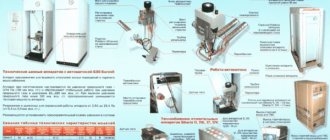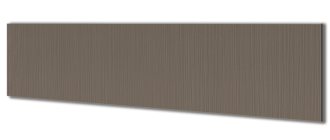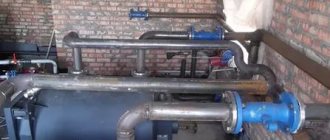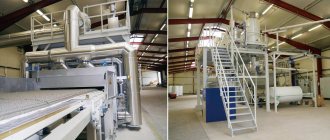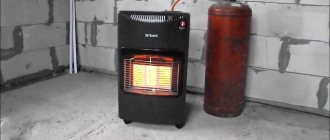IR devices that generate heat and light fluxes are actively used in various areas of production and private economy. Gas infrared emitters are most in demand for industrial premises. Their action is based on the ability of a heated body to release the resulting heat into space.
You will learn everything about the operating principles of infrared equipment from our proposed article. We will talk about the types of infrared equipment and their characteristic differences. Let's introduce the leading models on the market.
Gas heaters: design, types, advantages and disadvantages
Gas heaters produced by manufacturers differ in their power, operating principle and cost. They can be stationary and portable. The first type of equipment is made in the form of convectors and heat guns.
Heaters can be connected to main gas or bottled equipment. Stationary gas heaters are characterized by a large volume of blue fuel consumption. They have high efficiency and productivity.
Installation of stationary gas heaters requires the installation of chimneys. To install them, you need to allocate a separate corner in the room with an area of at least 1 square meter. m. Mobile heaters can be used for temporary and permanent heating of premises. Such models have smaller dimensions, light weight and are inferior to stationary units in performance.
According to the principle of operation, gas heating equipment is divided into:
infrared;- catalytic;
- convection
Each type of equipment has its own advantages and disadvantages. Manufacturers produce heaters of various configurations. This allows them to be installed in various places in country premises.
Depending on the installation location, devices are distinguished:
- corner;
- built-in;
- wall;
- frontal.
Review of IR heater manufacturers
Gas appliances for creating a favorable microclimate at a construction site, workshop, production workshop and similar facilities are produced by both domestic companies and foreign companies.
According to consumers, the rating of Russian-made products is topped by gas burners of the Solarogaz brand. The assortment presented by this company includes models designed for heating areas of various sizes. The units can be used in greenhouses, garages and open areas.
One of the most popular types of gas infrared equipment on the domestic market and proven in practice is the line of gas burners and stoves from the company Solarogaz
The only negative that buyers and actual owners of gas burner and stove models from the capital’s manufacturer should take into account is the lack of security system sensors. Therefore, they can be used in everyday life, but with precautions.
Products from the Pathfinder company are not inferior in popularity. However, the product line offered to the buyer is dominated by products for household use and tourist options.
Image gallery
Photo from
Tourist gas burner Pathfinder
Cylinder connection device
Adapter for connecting to a collet cylinder
Complete set of mobile gas burner
Tiles, used both for heating and in preparing simple dishes, and mini burners from a spray can are justifiably popular.
Gas heaters with the Aeroheat logo received excellent characteristics from consumers. This equipment is attractive due to its reliability, based on the use of high-quality components, and its affordable price. Gas-powered stoves and burners from Dixon and Sibiryachka have proven themselves well.
The list of worthy gas heaters from foreign suppliers is headed by gas burners and stoves from the South Korean company Kovea. The brand's products are actively used in small workshops, at painting and construction sites, on hiking trips and fishing.
Gas stoves and burners from Hyundai are not inferior in quality and technical characteristics to devices from European manufacturers. In some indicators they even surpass
To equip workshops, gas heaters from the Italian company Sistema are often used. Models from South Koreans Hyundai and Italian gas stoves Bartolini, which can be used both at home and in the office, are actively in demand. Swedish Timberk stoves and Chinese Ballu equipment are distinguished by their reliability and stable operation.
Catalytic heaters
The quietest and most fireproof gas heating appliances. There are no burners in their design. They are replaced in equipment by catalytic panels. There is no combustion process in structures of this type. Heat is released as a result of a chemical gas oxidation reaction that occurs on the catalytic panel.
The advantages of catalytic heaters are:
- compactness;
- no emissions of carbon dioxide and carbon dioxide;
- energy independence;
- high level of security.
Despite the increased safety of the equipment, it should not be used in rooms where there is no ventilation. Catalytic heaters can transfer heat in two ways: convection and infrared.
Expert opinion
Chebatkov Maxim Pavlovich
Specialist in household appliances and their repair
Some models of this type have a double heating circuit. Uniform distribution of heat throughout the room is ensured by fans built into the design of the devices.
Types of devices
A gas air heater, like other heating equipment, is an excellent option for creating a comfortable temperature regime. Depending on the place of use, they are made in two types:
- Stationary are gas heaters using natural gas for the home; they are connected to the appropriate mains (they can also be powered by a liquefied gas cylinder); a prerequisite for installing such equipment is the presence of a chimney that ensures the removal of combustion products and the flow of air. For ease of use, models are available equipped with replaceable nozzles that provide various ways to connect the device.
- Portable devices are not able to provide full heating of a residential building or an entire apartment, so they are used in dachas, in the garage, to maintain heat in the room. Due to their mobility (small size and weight), the devices can be placed in any room and, if desired, moved to other rooms. Such heaters operate on liquefied gas (connected to a household cylinder).
In this video we will look at a gas heater and its capabilities:
For ease of placement, wall, floor and ceiling models are available. The combustion chambers also differ. The closed type of chamber is more practical to use, since the air required for combustion comes from the street and the products of work are discharged there.
Units with an open chamber are equipped with an analyzer and a safety valve (to shut off the device in a critical situation). Such devices are used in enclosed spaces if there is forced ventilation.
Despite the variety of models produced, gas heaters have the same components. The main components of the devices are:
More advanced modern appliances add a circuit breaker and thermostat for convenient and safe use. The process of heating a room with these devices also occurs differently, since they have different principles of operation and design.
The most common models of gas heaters are:
- Infrared heaters are equipped with metal or ceramic emitters that, when heated, emit heat (infrared waves), which heats the objects in the room, rather than the air.
- Catalytic models are considered safe. During operation, there is no combustion process itself; the release of thermal energy occurs as a result of a chemical reaction. The fuel supplied to the catalytic panel is oxidized, resulting in the release of heat. The room is heated using both convection and infrared or mixed types.
- Convection heaters are the simplest units. As a result of gas combustion, finned radiators heat up, from which heated air rises, and cold air falls in its place and heats up.
When used correctly, these devices will be reliable assistants capable of quickly creating a comfortable thermal regime in any room, even in the absence of electrical energy.
Infrared heaters
A distinctive feature of devices of this type is that they can be used not only for heating rooms, but also open areas. They are suitable for heating terraces of cafes and restaurants, country verandas, etc. The thermal energy released during gas combustion heats the objects surrounding the equipment. The generation of infrared radiation in the device occurs due to ceramic and metal heating elements.
The gas burners located inside the device housing are equipped with reflectors. They direct thermal energy in the right direction. The heating radius of the devices is 5-6 meters. Infrared heaters operate on natural and liquefied gas. Some designs are equipped with slots made in the form of a monoblock with a built-in cylinder.
Among the advantages:
- high efficiency;
- autonomy.
The disadvantage of infrared gas heaters is the fire hazard. In enclosed spaces intended for their installation, there must be ventilation.
Dark and light IR emitters
By definition, “bright” sources are capable of emitting light. The streams they emit are perceived by vision, although it is still difficult to call them bright lighting and should not be used for this purpose at all.
“Dark” devices deliver a flow of heat invisible to humans, felt by the user’s skin, but not visually detected. The boundary value between “light” and “dark” is considered to be a wavelength of 3 microns. The limiting temperature of the heated surface is 700º.
The property of infrared emitters to supply thermal energy is actively used in greenhouses, chicken coops and farms to support young animals
The most famous representative of a “dark” heating unit is the Russian brick stove, which has successfully heated low-rise buildings for many centuries. Among the “light” ones, as we already understand, is an incandescent electric light bulb, if it supplies no more than 12% of light. Its main energy is directed towards generating heat.
Features of the design of light fixtures
Structurally, light sources are similar to a typical incandescent lamp. However, there are differences in the filament bodies. For bright infrared devices, the temperature cannot exceed a limit of 2270-2770 K. This is necessary to increase heat flow by reducing light emission.
Just like standard light bulbs, the filament body, made of tungsten filament, is placed in a glass bulb. Only the flask is equipped with reflectors, thanks to which all radiant energy is focused on the heated object. In this case, a small part of the energy is spent on heating the bulb base.
The bulb of light infrared sources heats up to high temperatures, so it also participates in the process of heat transfer into space. The thermal energy from the heated flask is not focused by the reflector and goes out into the untreated space; it is the component that reduces the efficiency of the device.
In design and connection method, infrared lamps are very similar to conventional incandescent light bulbs. However, their operating temperature of the filament body is significantly lower, due to which the service life is increased many times over.
The productivity of a light infrared source on average does not exceed 65%. It is increased by placing a tungsten heating body in a tube or similar flask made of quartz glass. This solution makes it possible to increase the wavelength to 3.3 microns and reduce the temperature to 600º.
This option is used in quartz IR heaters, in which chromium-nickel wire is wound around a quartz rod and the whole thing is placed together in a quartz tube.
Light infrared emitters have low performance. The efficiency of their infrared flux usually does not exceed 65%
The essence of the work is the double use of filament wire. The released thermal energy is partially used for direct heating, and partially for increasing the temperature of the quartz rod. A red-hot rod also emits heat.
The advantages of tubular devices include, quite reasonably, the resistance of all components made of quartz and ceramics to atmospheric negativity. The downside is the fragility of ceramic parts.
Specifics of operation and design of dark heaters
The so-called “dark” sources of IR fluxes are much more practical than their “light” counterparts. Their radiating element differs in structure for the better. The heated conductor itself does not emit thermal energy; it is supplied by the surrounding metal shell.
As a result, the operating temperature of the device does not exceed 400 - 600º. To ensure that thermal energy is not wasted, dark emitters are equipped with reflectors that redirect the flow in the desired direction.
Long-wave emitters of the dark group are not afraid of shocks and similar mechanical influences, because the fragile polymer or ceramic element in them is protected by a metal casing and a protective heat-insulating layer. The efficiency of emitters of this group reaches 90%.
Image gallery
Photo from
Infrared emitter in a cafe
IR heating device in a production room
Installing the emitter at the entrance to the house
Warming IR emitter at home
But they are not without their drawbacks. Dark group heaters depend on the design features of the device. If the distance between the main radiating element and the surface of the device is large, then it will be washed and cooled by the air flowing past. As a result, efficiency decreases.
Due to their design features, dark models are installed for heating rooms with low ceilings and areas that require linear heat supply. Light - placed where processing of rooms with high ceilings and vertically elongated areas is required.
Ballu BOGH-15E
Country of origin: Russia. The infrared type model is designed for outdoor heating and lighting. The design has the shape of a vertical flask.
Suitable for installation in a barbecue area in the garden yard. A special feature of the model is the ability to adjust the height of the flame, which can be done manually or remotely using the control panel.
The heater body is made of alloy steel, which has increased resistance to corrosion. A tetrahedral reflector located on top of the structure serves as protection for the device from precipitation.
Its surface area is 0.5 square meters. m. The model has a multi-level protection system. When the flame is tilted more than 45 degrees, it is extinguished by thermoelectric sensors that shut off the gas supply. They also monitor possible gas leaks.
Expert opinion
Chebatkov Maxim Pavlovich
Specialist in household appliances and their repair
The mobile design easily moves on flat surfaces due to the built-in wheelbase. There is a slate magnetic surface at the bottom of the case. When placed on the summer terraces of cafes, you can place advertisements on it.
Specifications:
- gas consumption – 300-900 g/hour;
- maximum power – 13 kW.
Advantages:
- 100% fuel combustion;
- increased recoil of the glass flask;
- possibility of remote control;
- attractive appearance;
- several combustion intensity modes;
- mobility.
Main disadvantage:
- high price.
Criterias of choice
When purchasing a gas heater, you should decide which type is more suitable for heating the room. Each model works effectively only under certain conditions. When choosing, you need to take into account the main characteristics of the device, such as:
- Open or closed type of gas convector. In the second option, it becomes necessary to bring the coaxial pipe outside.
- The area of the heated room.
- The power of the device (the greater it is, the larger the object it can heat).
- Heating temperature.
- Where will the device be used (indoors or outdoors).
- Availability of protective functions.
Due to their efficiency and breadth of use, gas heaters compete with other heating devices. Independent of electricity and having a neat appearance, they firmly retain the won trust of their consumers.
Asama Trade LLC offers to buy gas outdoor infrared heaters from leading manufacturers. The catalog presents models with different thermal power and heating radius. Here you can choose suitable devices for a country house, an open veranda, a summer cafe, or events taking place in the open air. Their thoughtful design fits perfectly into any architectural style.
Heating units are suitable for both domestic and commercial use. Purchasing gas heaters for a cafe can significantly extend the operating season of a summer area or veranda. Even in our latitudes, with their help you can maintain a comfortable temperature until late autumn without significant costs.
The advantages of gas heaters for cafes and open areas include:
- safe operation on liquefied natural gas,
- high strength and long service life of stainless and other steel structures,
- heating diameter up to 6 m,
- ease of installation and operation,
- economical fuel consumption,
- aesthetic design, including open flame (“pyramid”).
This is the best way to heat an open space. Infrared radiation does not heat the atmosphere; heat primarily reaches people and objects with which they come into contact. To operate the device, ordinary bottled gas is used, the cost of which is low. It is also important that the structure is mobile and can be easily moved around the site.
KOVEA Power Sense (KH-2006)
Country of origin: South Korea.
The lightweight model of the gas heater weighs only 1.4 kg. Designed for heating a room with a volume of up to 10 cubic meters. m. The design is equipped with piezo ignition and an overpressure valve. The infrared emitter is made of tungsten. The device operates from a collet standard gas cylinder.
The device body is made of aluminum. The material is lightweight and highly resistant to corrosion. This allows the heater to be operated in conditions of high air humidity.
It produces powerful heat even at noticeably low temperatures. The body of the device rests on four fixed supports, which allows it to be installed even on corrugated surfaces.
The device is turned on using a special handle designed to supply gas. The type of gas used is butane.
Specifications:
- fuel consumption – 75 g/hour;
- maximum power – 1.53 kW.
Advantages:
- light weight;
- mobility;
- low cost;
- low gas consumption.
Main disadvantage:
- low power.
Types of infrared heaters for industrial use
*
So, IR heaters are recognized as the most effective and appropriate for production conditions, since they do not use air as a transit medium (drafts are common in workshops) and therefore are suitable for working in open areas, have a high heat transfer rate and are effective for heating moving objects (conveyors , drying chambers, kilns).
But infrared radiation can be obtained by using various energy carriers, which determine the design of the heaters. Let's look at the most common types of infrared heaters produced for industrial needs.
Electric IR heaters for industry
Installation of such units is carried out on ceilings or walls, control is carried out mainly from wired wall-mounted devices, but for ease of use, some models provide remote wireless control and, in addition, the ability to connect to a thermostat.
The power of electrical units is in the range of 2-7.5 kW, which determines the consumed voltage - 220 or 380 V.
Manual heater remote control and signal switch location.
Structurally, industrial infrared electric heaters consist of a metal body, a reflector-reflector and an infrared wave emitter.
The body is covered with a heat-resistant protective paint and varnish composition, usually made by spraying. In order to increase the reflective area, the reflector is made corrugated.
As a radiator, industrial electric IR heaters use quartz or halogen lamps with a special coating on the bulb (carbon ones are not used due to their low power) or heating elements (tubular electric heaters).
Methods of mounting infrared industrial heaters are remote brackets and hanging devices.
Heating elements, in turn, can be of an open or closed arrangement.
*
With an open layout, the heater in the housing is visible and, although the unit is equipped with a protective grille, the heater is less safe, since its temperature after heating reaches 800 degrees. Heaters with heating elements of an open design are mounted in places inaccessible to personnel and are used in industrial premises with significant ceiling heights (10 m or more), in the absence of external thermal insulation, with drafts or the need for regular ventilation.
Infrared electric heaters with an open heating element.
In a closed position, the heating element is located behind a corrugated metal plate that does not contact it directly and therefore heats up only to 200 degrees, which increases the safety of the electric heater, but reduces the heating efficiency. Units with closed heating elements are used in non-ventilated rooms with external wall insulation.
To calculate the efficiency of an industrial heater in a specific room, a value called power density is used, measured in watts per square meter (W/m2) - the amount of power to provide the required temperature conditions over an area of 1 m2. The calculated values are tabulated taking into account the region, the degree of thermal protection of the enclosing structures and the recommended temperature threshold for a given production. For example, to maintain a room temperature of 19 degrees, you need to spend up to 100 W per 1 sq. meter of mercy.
Installation of wall and ceiling IR heaters for industrial use is carried out in accordance with GOST standards and manufacturer's recommendations, including location, orientation and installation height.
Gas industrial infrared heaters
The high power of industrial heaters causes increased energy consumption, so gas heaters are mainly designed for mains natural gas, but there are also models that consume propane (butane).
Gas infrared heater in action. It is possible to connect a thermostat controlled remotely.
*
Industrial infrared gas emitters are classified according to the temperature of the heat transfer plane - into “light” (800–1000°C) and “dark” (300–600°C) types.
Gas infrared heaters of the light type are designed for heating large areas with high ceilings - production workshops, warehouses, agricultural and zootechnical premises, equipped with canopies for open areas, etc.
Important! “Light” type IR heaters belong to gas equipment of group A1 - combustion products are not discharged anywhere and remain in the heated room, which must be equipped with a forced exhaust ventilation system.
The design diagram of a “light” type IR gas heater indicates that there is no removal of gas combustion products.
Gas IR heaters of the “dark” type are structurally a pipe with a diameter of 75 to 120 mm, with a burner mounted at one end and a fan at the other.
Device diagrams and operating principles of industrial gas infrared heaters of the “dark” type.
The pipe is made of a special heat-emitting alloy or coated with a heat-resistant coating with identical properties and placed on a steel sheet with a mirror surface.
Gas (natural or liquefied) is supplied to the burner, which, when burned, heats the pipe from the inside and initiates infrared radiation from it.
Most - 50-75% of the thermal energy is transferred to the surface of the pipe and is directed downwards in the form of infrared radiation - towards the floor, the middle and lower zones of the walls of the room, as well as equipment, which is facilitated by a mirror reflector located behind the pipe.
25-40% of the thermal energy from gas combustion goes to compensate for heat loss in the room through the roof, the upper zone of the walls, and only 5-10% of the heat goes into the atmosphere along with the gas combustion products discharged outside.
A real image of one of the models of a “dark” type gas infrared heater and its section.
*
Industrial gas heaters of the “dark” type are divided into the following types:
- modular - for local heating of limited areas or workplaces;
- strip (block) - designed for assembling heating systems of complex configurations that follow the geometry of the room.
On the left is a modular type and on the right is a strip type of “dark” gas IR heaters.
Gas infrared heaters are attractive due to the low cost of the energy used, but it should be remembered that gas is a fuel of increased danger of use, and the operation of such equipment requires more attention than the use of electric heaters.
Liquid fuel infrared industrial heaters
The energy carrier consumed by these units is diesel fuel or aviation kerosene.
The principle of operation of the device is based on heating the emitter with fuel burning in the nozzle and then emitting infrared wavelengths from it. Therefore, unlike a liquid fuel heat gun, these units do not create directed air flows that raise dust.
Liquid fuel IR heaters are produced for stationary (modular) and portable use. The design of stationary diesel IR heaters for industrial use resembles gas infrared units, but only at first glance - the difference in energy carrier determines a different design of components. The similarity of the systems can be seen using the example of the INFRA heater, which has proven itself well on the Russian market.
Diagram of the installation of an industrial infrared emitter using diesel fuel for stationary placement
Modular diesel infrared emitters are used for heating medium and large areas of industrial premises, indoor agricultural facilities (poultry farms, farms, greenhouses), warehouse areas and sports facilities. When choosing a heater of the required power, it is convenient to use the following table of the range of models of these units:
Portable diesel infrared heaters, although not compact, are no less effective than modular ones. Their design, thanks to a carriage with wheels, with the dimensions of the unit being more than a meter in length, allows one worker to move the equipment to the desired location. The heat transfer power of such devices can reach 40 kW or more with a fuel consumption of 2-3 kg/hour, which allows heating rooms with an area of 300-400 square meters. But efficiency also determines the price - the cost of top models can exceed one hundred thousand rubles.
Important! The use of energy carriers not specified in the user manual in liquid fuel IR heaters is prohibited.
Water thermal panels
This emitting infrared device for industrial use is a system assembled from separate sections, which are a profiled steel or aluminum reflector sheet in which a system of tubes is mounted for the movement of coolant - hot water. The sections are connected using fittings.
Types of heating sections with hot water supply and their connection
Such devices, with their simple design, are reliable, durable, highly economical and efficient in use. Of no small importance is the factor of the absence of flammable energy in the system, which makes the device absolutely environmentally friendly and highly safe.
Infrared heaters with hot water supply are mounted on the ceiling or walls and are ideal for industrial, agricultural, warehouse and other premises. The base planned for the placement of the heating system is pre-equipped with thermal insulation to reduce heat loss through the supporting structure. The insignificant weight of the sections in most cases does not impose additional requirements on the load-bearing characteristics of the base, and compliance with the installation rules recommended by the manufacturer ensures reliable installation of the device.
Timberk TGH 4200 SM1
Country of origin: China. The ceramic gas stove model is designed for heating rooms that do not have other types of heating, with an area of up to 60 square meters. m. The compact device runs on bottled propane or butane gas.
It is independent of electricity, has an attractive appearance and has increased safety. The body of the product is mounted on a wheelbase. This allows you to move it from one room to another without much effort.
A gas cylinder of up to 12 liters fits into the device body. Connection type: hose. The model is equipped with piezo ignition. The heating element of the structure is a ceramic panel.
It is lit by a wick. When heating, the infrared rays emitted by the device heat the objects and surfaces surrounding the device, which transfer their heat to the room.
Expert opinion
Chebatkov Maxim Pavlovich
Specialist in household appliances and their repair
The design is equipped with gas control sensors. They turn off the gas supply when the flame goes out and the CO2 concentration exceeds, as well as when the device falls. At maximum power, the heater can operate continuously for at least 17 hours.
Specifications:
- gas consumption – 0.3 kg/hour;
- maximum power – 4.2 kW.
Advantages:
- sequential start of a three-section burner;
- compactness;
- simple controls;
- rollover protection;
- presence of piezo ignition.
No deficiencies identified.
Top 5 rating according to KP
Bartolini Pullover I Turbo Plus (RUB 13,400)
Bartolini Pullover I Turbo Plus.
Photo: yandex.market.ru The combined gas heater Bartolini Pullover I Turbo Plus has 3 heating strips made of microporous ceramics, as well as a 2 kW fan heater. The model is very effective thanks to two types of power supply. Gas heating is carried out independently of the electrical network, and the electric fan heater can be turned on both simultaneously with the gas burners, and in autonomous mode, if suddenly problems arise with the gas supply.
Thanks to this versatility, the model is able to quickly heat and uninterruptedly maintain heat in a house with an area of up to 100 m2. By the way, a well-thought-out safety system allows you to use the device indoors - platinum coating on the heating panel helps to avoid CO2 leakage, there is a gas control, a fall shut-off sensor, and power adjustment.
A nice bonus is that the gas cylinder is covered with a plastic casing, which makes the heater look like a fireplace.
Advantages and disadvantages
Two types of power supply, gas control and rollover protection, powerful heating, economical
Not detected
show more
NeoClima 08HW-BW (from 30,000 rubles)
NeoClima 08HW-BW. Photo: yandex.market.ru
This model attracts attention with its appearance alone: it is made in a modern style. The pyramid shape will succinctly fit into any space. A distinctive feature of this device is that it heats not the air, but objects that are in the radiation zone. For the most comfortable use, manufacturers have provided several power modes.
The most accessible and inexpensive types of gas, in particular propane and butane, are used as an energy source for the NeoClima 08HW-BW infrared heater. Light weight and no need for permanent installation make the device very convenient for moving and transporting.
Advantages and disadvantages
Very original design, easy to operate, compact and light weight
Very high price. There are many analogues on the market that are much cheaper
show more
Timberk TGH 4200 M1 (5480 rub.)
Timberk TGH 4200 M1. Photo: yandex.market.ru
The Timberk TGH 4200 M1 gas heater is one of the most economical. Its power varies depending on the set mode. Thanks to this, a 15-liter propane-butane cylinder will last for almost 15 hours of continuous operation in economy mode and up to 7 hours at maximum power.
In addition to efficiency, the device’s safety system also deserves attention. Built-in sensors for flame, tilt of the device and oxygen content in the room, if necessary, quickly shut off the gas supply to the burner. This model is perfect for an apartment, a private house, or a summer house.
Advantages and disadvantages
Piezo ignition, powerful heating, numerous sensors for protection against emergency situations, low gas consumption, convenient wheels for transportation, power adjustment
There is no switch - to turn it off you need to turn off the gas supply
show more
Alpine Air NGS-20F (RUB 19,900)
Alpine Air NGS-20F. Photo: yandex.market.ru
This is an excellent choice for a private home or cottage where there is no separate room for a gas boiler or little space to install a heater. The Alpine Air NGS-20F gas heater is wall-mounted and provides amazing efficiency. With a power of 1.9 kW, the device is capable of heating a room up to 38 m2.
The main advantage of this model compared to competitors is durability. The device is equipped with a cast iron heat exchanger, the life of which is at least 50 years. All your electronics may fail, but you don't have to worry about the heat exchanger for the next 50 years.
The Alpine Air NGS-20F gas wall heater combines reliable and time-tested technologies combined with modern electronics. Electronics are responsible for the safe operation of equipment, and technology is responsible for heating the room.
Depending on the configuration, this heater can consume fuel from a gas cylinder or directly from the main gas system. In the second case, it is better to install a full-fledged gas boiler. For a dacha, a wall heater with a gas cylinder is enough.
Advantages and disadvantages
Durability, powerful heating, power adjustment, efficiency
Combustion products are vented outside through a special coaxial tube, which must be vented outside the room
show more
KAMtec KT-1300P (from 3,200 rubles)
KAMtec KT-1300P. Photo: yandex.market.ru
This device belongs to the short-wave type of infrared heaters. The heat from it is similar to the heat from the sun or a fire, but it does not contain ultraviolet radiation. The heater has a compact size, light weight and high heat output, thanks to the ceramic heating element. If the gas cylinder overheats, the device automatically stops burning. The bright color of the case will prevent you from losing it in an open space. Ease of transportation is achieved thanks to the handle, which is located on top of the body.
Advantages and disadvantages
Low price, compactness and simplicity, bright design
Limited functionality, cannot be left unattended
show more
This is interesting
How Mobile ID simplified life for all lovers of online services and shopping
How to choose gas heaters for a summer house
The best option for heating residential premises with non-permanent residence may be portable devices of a catalytic operating principle. This is the safest option for gas equipment.
Factors determining the choice of device include:
- heater power;
- price;
- installation methods.
Most dacha communities are not connected to gas mains. Heaters powered by balloon equipment are suitable for them. It makes sense to install stationary gas appliances in dachas with year-round residence. They connect to pipes and radiators.
Pros and cons of different types of gas heaters
The large selection of different models often simply leads to a stupor. Which heater will be better? Unfortunately, there is no definite answer; each type is bad in some ways and good in some ways. To choose the unit that is suitable for your needs, you need to familiarize yourself with their pros and cons.
We will not study the convection heater, since there are more modern and safer models. Instead, let's consider a new generation ceramic gas heater. Below are tables with the positive and negative characteristics of each type.
Catalytic
| pros | Minuses |
| Very compact. The operating principle allows you to keep the size of the device to a minimum. | Cannot be used in confined spaces. Be sure to have good ventilation. |
| No additional pipes or dirt, since there are no combustion products. | |
| The device does not require electricity to operate - it is completely autonomous. | |
| Economical fuel consumption. | |
| Safety. There are no burners or open flames. |
These devices are very effective. As stated above, heating can occur in three ways. Some models are additionally equipped with fans for uniform heat distribution.
Infrared
| pros | Minuses |
| Possibility of heating open and closed spaces. Such models are great for cafes, playgrounds or pool areas. | Burns oxygen. That is, ventilation is necessary in any case. |
| Large coverage area - outdoor models can heat objects at a distance of up to 6 meters. | Low fire protection. Even with the maximum protective measures taken by manufacturers, the device can cause a fire. |
| Mobility. Lightweight and compact models. | |
| High efficiency. | |
| In most cases, the device operates completely autonomously. |
Question answer
What type of gas heater is best to choose for constant heating of rooms?
For these cases, wall-mounted models of gas equipment are best suited.
Which gas heaters are 100% safe?
If the rules for operating devices are violated, no device can give a 100% guarantee of safety.
To heat which rooms can a gas fuel heat gun be used?
In dachas, such devices can be used to heat residential premises, as well as basements and garages.
How to choose the right power of an infrared gas heater for residential premises in the country?
The area required for heating residential premises is determined at the rate of 1 kW per 10 square meters. m. This standard is adopted for standard insulation of a building. If the thermal insulation of a country house is poor, this figure must be increased 3 times.
What should you consider when heating your home with gas appliances?
Living spaces heated by gas equipment require regular ventilation.
Gas heaters are an ideal option for heating cottages that are not used for winter living. This equipment has high efficiency. Gas heating allows you to save significant amounts of money on heating.
Installation of gas outdoor infrared heaters
The device has a stable design thanks to the extended base on which the container for the gas cylinder is placed. Air supply to support combustion is carried out through the grate. The upper part of the heaters has a reflector made in the form of a lantern (fungus). It houses a burner, which is connected to the cylinder with flexible hoses stretched inside the device stand. The combustion power of a gas outdoor infrared heater is smoothly adjustable. The design provides a gas shut-off protection system in the absence of flame and overturning.
We offer models in various price categories and provide wholesale discounts. Our specialists provide assistance in choosing gas heaters for cafes and countryside recreation.
But if you are still not sure of your choice or you do not have enough time or patience for this, feel free to dial: 8-495-744-66-10 or leave a request for a call back.
For those who have already moved from city high-rise buildings to a cozy home, the issue of heating in winter is quite acute. As you know, the cheapest fuel at the moment is gas. So in this article we will look at what types of gas heaters there are, their advantages and disadvantages.
Which gas IR heater is right for you?
Our experts recommend the Ballu BIGH-55 IR heater as a universal option for heating rooms and open areas.
Do you want to buy a gas infrared heater for your cottage, home or open area? There are a lot of models on sale, and it’s easy to get confused in this abundance. We can recommend you the following model - IR heater Ballu BIGH-55 from the Galaxy2 series. The device combines infrared and convection operating principles . Power is supplied from plug-in and built-in (up to 27 liters) cylinders.
For outdoor use, we recommend purchasing tall models that resemble a column, or a street lamp with an umbrella reflector. This device will create a circular heating zone, giving warmth to people and surrounding objects. Such devices can be used in any weather - an excellent choice for restaurants with open terraces and for lovers of evening tea in the country house or veranda.
For industrial use, we recommend taking a closer look at ceiling gas heaters. They provide uniform heating of a large area with minimal gas consumption. Such devices are used for heating production workshops, utility rooms and warehouses.
Do you need a universal gas heater for any operating conditions? Pay attention to compact, small-sized models with connected gas cylinders. They have minimal dimensions and are characterized by good performance. Such models are useful for heating country houses, private households, utility rooms, as well as for heating small open areas.
